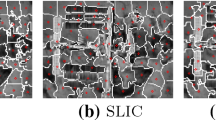Abstract
The Saliency Network proposed by Shashua and Ullman (1988) is a well-known approach to the problem of extracting salient curves from images while performing gap completion. This paper analyzes the Saliency Network. The Saliency Network is attractive for several reasons. First, the network generally prefers long and smooth curves over short or wiggly ones. While computing saliencies, the network also fills in gaps with smooth completions and tolerates noise. Finally, the network is locally connected, and its size is proportional to the size of the image.
Nevertheless, our analysis reveals certain weaknesses with the method. In particular, we show cases in which the most salient element does not lie on the perceptually most salient curve. Furthermore, in some cases the saliency measure changes its preferences when curves are scaled uniformly. Also, we show that for certain fragmented curves the measure prefers large gaps over a few small gaps of the same total size. In addition, we analyze the time complexity required by the method. We show that the number of steps required for convergence in serial implementations is quadratic in the size of the network, and in parallel implementations is linear in the size of the network. We discuss problems due to coarse sampling of the range of possible orientations. Finally, we consider the possibility of using the Saliency Network for grouping. We show that the Saliency Network recovers the most salient curve efficiently, but it has problems with identifying any salient curve other than the most salient one.
Similar content being viewed by others
References
Alter, T.D. and Basri, R. 1996. Extracting salient contours from images: An analysis of the saliency network. In Proc. IEEE Conf. Computer Vision Pat. Rec., San Francisco, CA.
Amini, A.A., Weymouth, T.E., and Jain, R.C. 1990. Using dynamic programming for solving variational problems in vision. IEEE Transactions on Pattern Anal. and Machine Intell., 12(9):855- 867.
Brady, M., Grimson, W.E.L., and Langridge, D.J. 1980. Shape encoding and subjective contours. In Proc. First Annual Conf. Artif. Int.
Brady, M. and Grimson, W.E.L. 1981. The perception of subjective surfaces, MIT A. I. Memo No. 666.
Bruckstein, A.M. and Netravali, A.N. 1990. On minimal energy trajectories. Computer Vision, Graphics, and Image Processing, 49:283-296.
Elder, J. and Zucker, S. 1993 The integration of figure fragments into representations of planar shape. McGill Research Centre for Intelligent Machines TR-93-2.
Finkel, L.H. and Sajda, P. 1992. Object discrimination based on depth-from-occlusion. Neural Computation, 4:901-921.
Freeman, W.T. 1992. Steerable filters and local analysis of image structure. Ph.D. Thesis, M.I.T. Media Lab, Technical Report 190.
Geiger, D., Gupta, A., Costa, L.A., and Vlontzos, J. 1995. Dynamic programming for detecting, tracking, and matching deformable contours. 17(3):294-302.
Grossberg, S. and Mingolla, M. 1987. Neural dynamics of surface perception: Boundary webs, illuminants, and shape-from-shading. Computer Vision, Graphics, and Image Processing, 37:116-165.
Guy, G. and Medioni, G. 1993. Inferring global perceptual contours from local features. Proc. DARPA Image Understanding Workshop, Washington, D.C., pp. 881-892.
Heitger, F. and Rüdiger von der Heydt. 1993. AComputational model of neural contour processing: Figure-ground segregation and illusory contours. In Proc. of ICCV, pp. 32-40.
Herault, L. and Horaud, R. 1993. Figure-ground discrimination: A combinatorial optimization approach. IEEE Trans. on Pattern Analysis and Artificial Intelligence, 15(9).
Horn, B.K.P. 1983. The curve of least energy. ACM Trans. on Math. Soft., 9(4):441-460.
Jacobs, D.W. 1993. Recognizing 3-D objects using 2-D images. MIT Artif. Intell. Lab. Tech. Report 1416.
Kass, M., Witkin, A., and Terzopolous, D. 1988. Snakes: Active contour models. Inter. J. Computer Vision, 1(4).
Martelli, A. 1976. An application of heuristic search methods to edge and contour detection. Comm. ACM, 19(2).
Mohan, R. and Nevatia, R. 1988. Perceptual grouping for the detection and description of structures in aerial images. In Proc. DARPA Image Understanding Workshop, pp. 512-526.
Mohan, R. and Nevatia, R. 1992. Perceptual grouping for scene description and segmentation. Trans. on Pattern Analysis and Machine Intelligence, 14(6).
Montanari, U. 1971. On the optimal detection of curves in noisy pictures. Comm. ACM, 14(5).
Mumford, D. 1994. Elastica and computer vision. In Algebraic Geometry and Its Applications, Chandrajit Bajaj (Ed.), Springer-Verlag, pp. 491-506.
Parent, P. and Zucker, S.W. 1989. Trace inference, curvature consistency, and curve detection. Trans. On Pattern Analysis and Machine Intelligence, 11(8).
Pavlidis, T. and Liow, Y.-T. 1990. Integrating region growing and edge detection. Trans. on Pattern Analysis and Machine Intelligence, 12(3):225-233.
Rutkowski, W.S. 1979. Shape completion. Computer Vision, Graphics, and Image Proc., 9:89-101.
Sha'ashua, A. and Ullman, S. 1988. Structural saliency: The detection of globally salient structures using a locally connected network. In 2nd ICCV, pp. 321-327, also Weizmann Institute of Science Report CS88-18, 1988.
Sha'ashua, A. and Ullman, S. 1990. Grouping contours by iterated pairing network. In Advances in Neural Information Processing Systems 3, R.P. Lippmann, J.E. Moody, and D.S. Touretzky (Eds.), pp. 335-341.
Subirana-Vilanova, J. 1991. Curved inertia frames: Visual attention and perceptual organization using convexity and symmetry. MIT A. I. Memo No. 1137.
Subirana-Vilanova, J. and Sung, K.K. 1992. Multi-scale vectorridge-detection for perceptual organization without edges. MIT A. I. Memo No. 1318.
Ullman, S. 1976. Filling-in the gaps: The shape of subjective contours and a model for their generation. Biological Cybernetics, 25: 1-6.
Webb, J.A. and Pervin, E. 1984. The shape of subjective contours. Proc. National Conf. on Artificial Intelligence, pp. 340- 343.
Weiss, I. 1988. 3D shape representation by contours. CGVIP, 41: 80-100.
Williams, L.R. and Hanson, A.R. 1994. Perceptual completion of occluded surfaces. In Proc. IEEE Conf. Computer Vision Pat. Rec., Seattle, WA. Also to appear in Computer Vision and Image Understandin.
Williams, L.R. and Jacobs, D.W. 1995. Stochastic completion fields: A neural model of illusory contour shape and salience. In Proc. Fifth Inter. Conf. on Computer Vision, pp. 408-415.
Author information
Authors and Affiliations
Rights and permissions
About this article
Cite this article
Alter, T., Basri, R. Extracting Salient Curves from Images: An Analysis of the Saliency Network. International Journal of Computer Vision 27, 51–69 (1998). https://doi.org/10.1023/A:1007953729443
Issue Date:
DOI: https://doi.org/10.1023/A:1007953729443




